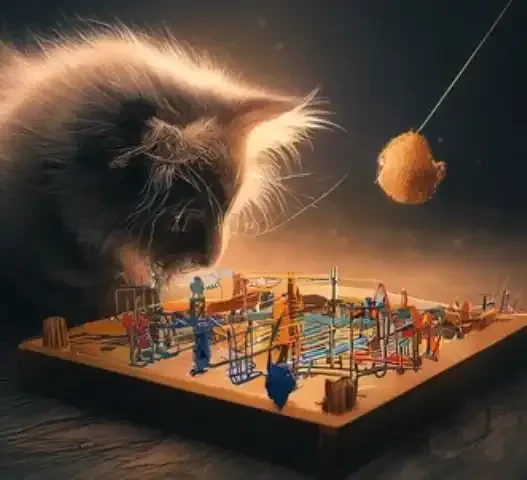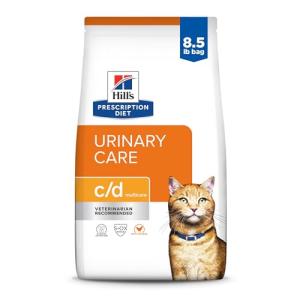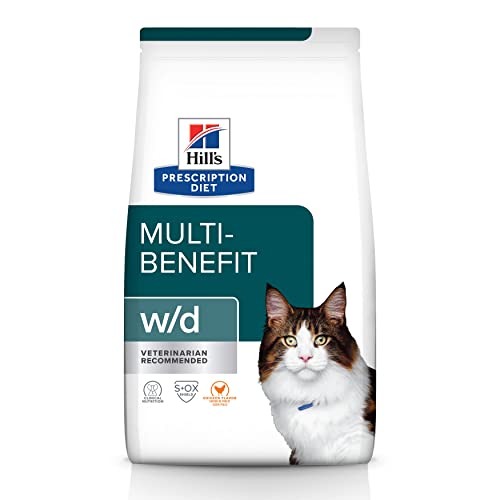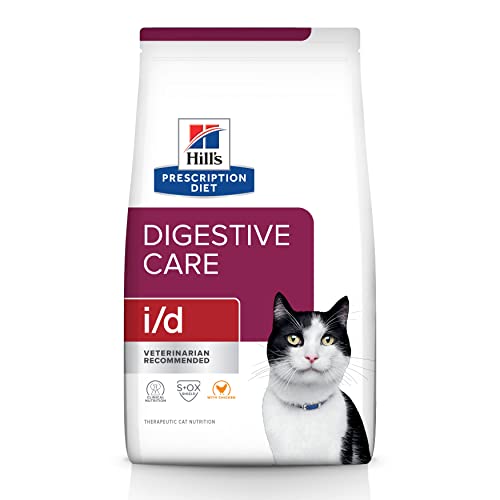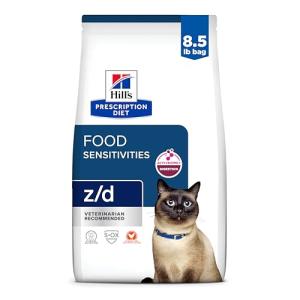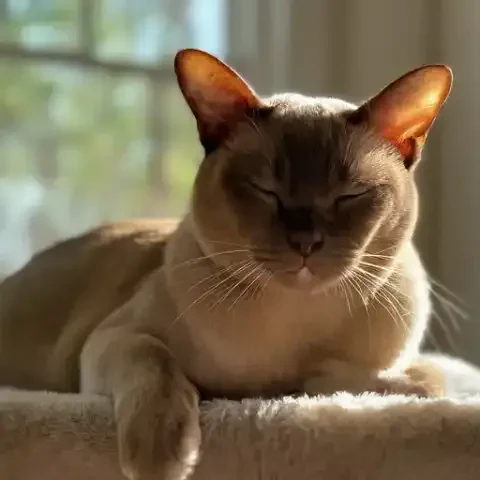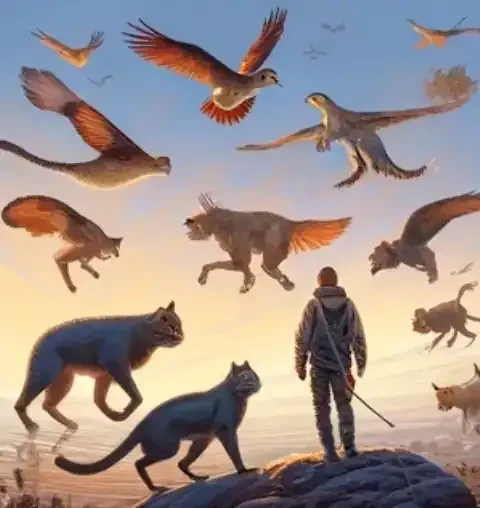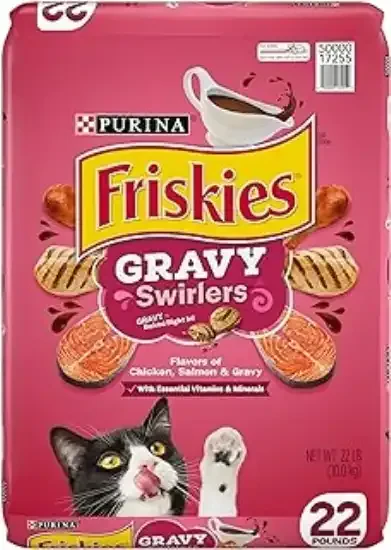Hold on a moment. Pause whatever you're doing. And let's just be brutally honest with ourselves, shall we? Cats are… weird. Gloriously, undeniably, hilariously weird. We adore them, of course, these enigmatic, purring, occasionally demanding creatures who share our homes and, let's face it, rule our lives. But amidst the cuddles and the purrs and the aesthetically pleasing fur patterns, there exists a constant undercurrent of pure, unadulterated feline… strangeness. Have you ever truly paused, amidst the daily feline-induced chaos, to wonder why they do those utterly bizarre things that make us laugh, scratch our heads, and occasionally question our own sanity? Why the sudden, inexplicable sprints through the house at 3 AM? Why the unwavering, almost gravitational, pull of the humble cardboard box? Why the kneading, those rhythmic paw massages accompanied by blissed-out expressions and borderline concerning levels of drool? From midnight zoomies that transform your living room into a feline racetrack to their uncanny ability to contort themselves into boxes half their size, cats are undeniably masters of the unexpected, virtuosos of the delightfully absurd. But beneath that fluffy, often perplexing exterior, lies a surprising amount of actual, genuine science underpinning their quirky habits. These aren't random acts of feline madness; these are behaviors rooted in evolution, shaped by biology, and driven by the intricate workings of the feline psyche. This, dear reader, is not just another collection of funny cat anecdotes (though we promise, there will be humor aplenty). No, this is an attempt to decode feline weirdness, to delve beneath the surface of their chuckle-worthy antics and explore the scientific principles that drive their most head-scratchingly hilarious behaviors. We're about to embark on a journey, a lighthearted yet informative expedition, to uncover the “why” behind the “what” of feline strangeness, all through the surprisingly illuminating lens of science. Prepare to have your understanding of your feline companion deepened, your appreciation for their quirky charm amplified, and your own sense of amusement thoroughly… well, amused, as we unravel the mysteries behind the zoomies, the box obsession, the kneading enigma, the wall-staring phenomenon, and more, revealing the surprising, and often side-splitting, science behind your cat’s most chuckle-worthy antics.
Let's kick off our scientific exploration into feline funniness with a behavior that is both universally recognized and utterly, gloriously, bizarre: the midnight zoomies. Ah, the zoomies. That sudden, unexplained, almost volcanic eruption of frantic feline energy that can transform even the most tranquil household into a scene of controlled (or, more accurately, uncontrolled) chaos. One moment, your cat is the picture of serene feline repose, curled up in a sunbeam, fast asleep. The next? BAM! They are a furry, four-legged missile, tearing through the house at breakneck speed, a whirlwind of paws and fur leaving bewildered humans and startled dust bunnies in their wake. The midnight zoomies, often striking with impeccable (and deeply inconvenient) timing in the wee hours of the morning, are characterized by sudden, inexplicable bursts of running, racing from room to room with the single-minded determination of a caffeinated cheetah. They involve leaping over furniture with acrobatic flair (and occasional, less-than-graceful landings), bounding off walls with surprising force, and generally engaging in chaotic, directionless movement that seems, to the human observer, to lack any discernible purpose whatsoever. But is it truly purposeless? Is it simply random feline madness unleashed upon an unsuspecting household? Science, as it turns out, suggests otherwise. The science behind the sprint, the evolutionary underpinnings of the zoomies, reveals that these frantic bursts of energy are far from arbitrary; they are deeply rooted in feline biology and instinct. One key factor is the crepuscular nature of cats. Unlike diurnal creatures, who are most active during the day, or nocturnal animals, who are primarily active at night, cats are crepuscular, meaning they are naturally most active during dawn and dusk. These twilight hours, the liminal spaces between day and night, are prime hunting times in the wild, the periods when prey animals are often most vulnerable. And even though our pampered indoor cats may never need to stalk a field mouse or chase down a songbird, those primal hunting instincts, honed over millennia of evolution, remain deeply ingrained within their feline DNA. Zoomies, particularly those that strike at dawn and dusk, are often interpreted as a manifestation of these ingrained hunting instincts, a biological echo of their wild ancestors preparing for the hunt during those twilight hours. They are, in essence, a form of phantom practice, a high-energy rehearsal for a hunt that will likely never actually occur, but is nonetheless driven by deep-seated evolutionary programming. Another crucial element in the zoomie equation is energy release. Cats, as we all know, are masters of the nap. They are capable of achieving levels of daytime slumber that would make even the most dedicated sloth envious. And all that prolonged periods of rest, all those accumulated hours of feline downtime, inevitably lead to a buildup of pent-up energy, a reservoir of kinetic potential just waiting to be unleashed. Zoomies become the pressure valve, the release mechanism for this accumulated energy, a necessary, albeit often disruptive, outlet for their naturally cyclical patterns of rest and activity. Think of it as feline physics: prolonged inactivity must be balanced by bursts of intense activity, and the zoomies are nature’s gloriously chaotic, and thoroughly entertaining, way of achieving that equilibrium. And the reason the zoomies look so undeniably, hilariously funny? Well, that too, can be analyzed through a slightly scientific, albeit primarily comedic, lens. It’s the sheer exaggeration of their movements, the almost cartoonish over-the-top athleticism of their leaps and runs, that contributes to the comedic effect. It’s the seeming randomness of their trajectory, the sudden, unpredictable changes in direction, the chaotic, almost pinball-like ricocheting off furniture, that amplifies the humor. And of course, the inherent comedic surprise of it all – the stark contrast between their usual, serene, almost regal demeanor and the sudden, frenetic, utterly unhinged energy of the zoomies. It’s the unexpected juxtaposition of feline calm and feline chaos that makes the midnight zoomies such a consistently chuckle-worthy spectacle. So, what are the practical implications of zoomie science for the average cat owner? Well, armed with this newfound understanding of the evolutionary and biological drivers behind these frantic bursts of energy, we can, perhaps, approach the midnight zoomies with a slightly more… tolerant… perspective. Instead of viewing them as purely disruptive or intentionally mischievous, we can recognize them as a natural, instinct-driven behavior, a feline need to release pent-up energy and express their inner wildcat. And, dare we suggest, perhaps even attempt to channel that zoomie energy in a slightly more… constructive… direction. Interactive toys, strategically deployed during those crepuscular hours, might offer a valuable outlet for their hunting instincts, a way to redirect the zoomie chaos into something slightly less furniture-endangering. Think of it as zoomie redirection, a strategic maneuver to minimize household disruption and, perhaps, prevent further lamp casualties in the ongoing saga of feline energy expenditure.
Moving on from the chaotic sprints to the comforting confines, let’s delve into another universally recognized, and equally perplexing, feline fascination: the cardboard box conundrum. Ah, the cardboard box. That humble, ubiquitous, and utterly irresistible object that holds an almost magnetic allure for cats of all breeds, ages, and personalities. Present a cat with a pristine, plush, orthopedically designed cat bed, crafted from the finest materials and engineered for maximum feline comfort, and they might, perhaps, deign to sniff at it with a fleeting air of polite curiosity. But introduce a discarded cardboard box, a slightly dented, faintly smelling-of-packaging-peanuts Amazon delivery vessel, and watch as feline obsession ignites. Suddenly, the cardboard box becomes the epicenter of the feline universe, the coveted prize, the ultimate object of desire, relegating all other potential napping locations to the realm of utter insignificance. Cats’ unwavering attraction to cardboard boxes, regardless of size, shape, or structural integrity, is a phenomenon that has baffled and amused cat owners for generations. They will squeeze themselves into boxes that are demonstrably, objectively, too small for them, contorting their bodies into seemingly impossible configurations, overflowing from the sides like furry, four-legged sourdough starters. They will ignore spacious, comfortable cat beds in favor of cramped, flimsy cardboard containers, displaying a preference that seems to defy all logic, and certainly all human notions of comfort and practicality. But again, science, in its wonderfully illuminating way, offers insights into the seemingly illogical allure of the cardboard box. The science of the square, the instinctual drivers behind box love, reveals that this feline fascination is deeply rooted in their innate needs for security, shelter, and predatory behavior. One key factor is security and enclosed spaces. Cats, by nature, are both predators and prey. While they are adept hunters, they are also, in the wild, vulnerable to larger predators. Boxes provide a sense of enclosure, a safe, contained space that reduces stress and anxiety, offering a refuge from perceived threats and a sanctuary of feline solitude. Hiding in a box becomes a deeply ingrained instinct, a primal response to vulnerability, a way to create a miniature fortress of feline security within the potentially overwhelming vastness of their environment. Boxes also tap into their predatory instincts, offering the perfect hiding spot for ambush predators, even in the context of indoor play. A cardboard box becomes a hunting blind, a concealed vantage point from which they can stalk imaginary prey, pounce on unsuspecting toys, and generally engage in miniature predatory scenarios, even within the safe confines of their living room. And there's even a thermoregulatory aspect to the box obsession. Cardboard, surprisingly, is a relatively good insulator. Boxes can provide warmth in the winter, offering a cozy, insulated haven against colder temperatures, and, conversely, can offer a slightly cooler, more breathable refuge in the summer months, providing a degree of thermoregulation that appeals to feline temperature sensitivities. And perhaps most compellingly, studies, actual scientific studies, have demonstrated the stress-reducing effects of boxes on cats, particularly shelter cats. Research has shown that providing cats in shelters with cardboard boxes significantly reduces their stress levels, promoting faster adjustment to new environments and demonstrating the tangible psychological benefits of these humble cardboard containers. So, why does the box obsession look so undeniably funny to us humans? Well, it’s the comical sight of a cat squeezed into a box that is patently, hilariously, too small. It’s the inherent absurdity of their determination to contort their elegant feline forms into such ungainly, box-shaped configurations. It’s the sheer, unwavering dedication to fitting into any box, regardless of logic, practicality, or apparent feline comfort, that elicits chuckles and head-shakes from their human observers. And the practical implications for cat owners are, perhaps, delightfully simple: embrace the box love. Instead of fighting against the feline cardboard obsession, why not lean into it? Provide your cat with a steady supply of boxes, strategically placed throughout the house, offering them readily available sanctuaries of cardboard comfort and feline dominion. Think of it as giving in to the inevitable, surrendering to the feline box imperative, and, perhaps, even saving a little money on those expensive, and often pointedly ignored, cat beds.
Let us now turn our scientific gaze towards another quintessential, and endearingly perplexing, feline behavior: kneading. The kneading mystery, that rhythmic, almost hypnotic, paw-pushing motion that cats perform on soft surfaces, often accompanied by a chorus of contented purrs and blissed-out expressions. Witness the cat settling onto your lap, onto a plush blanket, onto the armrest of your favorite armchair, and then, the kneading begins. Paws rhythmically pushing and pulling, claws gently extending and retracting, a slow, deliberate, almost massage-like motion performed with unwavering focus and apparent feline bliss. Often accompanied by a symphony of purrs, a low, rumbling engine of contentment vibrating through their furry bodies. Drooling, in some particularly enthusiastic kneaders, might even become a factor, a glistening testament to the sheer, unadulterated pleasure derived from this seemingly simple act. And sometimes, less delightfully for furniture owners, the kneading might escalate to include actual scratching, claws extending with slightly less gentle intent, leaving tell-tale snags and scratches on the very surfaces they are ostensibly “comforting.” But beneath the surface of this seemingly simple, and often quite funny, behavior lies a deep evolutionary history, a link to kittenhood, and a complex interplay of comfort, communication, and feline contentment. The science of the squish, the evolutionary roots of kneading, traces this behavior back to the earliest days of feline life, to the fundamental bond between kitten and mother. Kneading originates from kitten nursing behavior. Newborn kittens instinctively knead around their mother’s teats while nursing, stimulating milk flow and maximizing their access to nourishment. This early association of kneading with comfort, security, and maternal care becomes deeply ingrained in their feline psyche, a Pavlovian link between paw motion and feelings of contentment. And this kittenhood behavior, remarkably, is retained into adulthood, albeit repurposed and recontextualized. Kneading in adult cats becomes a comfort behavior, a self-soothing mechanism that evokes those early feelings of security and contentment associated with kittenhood and nursing. It’s a regression, of sorts, a return to a primal state of comfort, a feline form of emotional self-regulation expressed through rhythmic paw motions. Kneading is also, subtly but significantly, a form of scent marking. Cats’ paws, remarkably, are equipped with scent glands. And kneading, that rhythmic pushing and pulling motion, can serve as a subtle way of depositing scent markings onto their chosen kneading surface, leaving their olfactory signature, claiming territory, and subtly communicating their presence to other felines (and perhaps, to discerning humans). And fundamentally, and perhaps most simply, kneading is a sign of contentment and happiness in adult cats. It is an outward expression of feline bliss, a visible manifestation of relaxation and pleasure, a purring, paw-pushing declaration of utter feline contentment. And why does it look so undeniably funny to us humans? Well, it’s the seemingly trance-like state cats enter while kneading, the glazed-over eyes, the blissed-out expression, the air of utter feline absorption in this rhythmic, repetitive motion. It’s the almost massage-like quality of their paw movements, the human-like action performed with such feline focus and intensity. And of course, the purring and drooling accompaniment, the multi-sensory overload of cuteness and slight absurdity, all combine to create a comedic spectacle that is both endearing and endlessly amusing. And the practical implications for cat owners, particularly those whose furniture bears the brunt of enthusiastic kneading claws? Well, gentle management and redirection are key. Providing appropriate kneading surfaces – plush blankets, designated cat beds, scratching posts strategically positioned near favorite kneading locations – can offer acceptable alternatives to your precious upholstery. Gentle redirection, calmly and consistently moving your cat to a designated scratching surface when kneading claws become a bit too enthusiastic on your lap, can help reinforce desired kneading locations. And ultimately, perhaps the best approach is simply acceptance. Accepting the feline massage, even if it occasionally comes with the subtle prick of tiny, enthusiastic claws. Recognizing kneading as a natural, instinctual, and ultimately comforting behavior, a small price to pay for the endless joy and amusement that our gloriously weird cats bring into our lives.
Finally, let’s turn our scientific attention to the enigmatic, often perplexing, phenomenon of the cat staring contest… with walls. The wall stare, the thousand-yard feline gaze directed at seemingly blank walls, empty corners, or utterly featureless ceilings. We’ve all witnessed it: the cat perched, motionless, utterly fixated, staring intently at a wall, a corner of the room, or a patch of ceiling that appears, to the human eye, to be utterly, definitively… blank. Prolonged, unwavering, unblinking gazes, directed at seemingly empty space, with no obvious target, no discernible point of interest visible to our less-sensitive human senses. It’s a behavior that evokes a sense of mystery, a feeling of feline inscrutability, a wondering about what exactly, in that seemingly blank expanse of drywall, has captured their unwavering feline attention. But is it truly blank? Is it emptiness that they are contemplating with such intensity? Or are they perceiving something, sensing something, experiencing a sensory world that lies just beyond the threshold of our limited human perception? The science of the stare, the sensory world of cats that lies beyond our own, reveals that these seemingly blank-wall-directed gazes are often anything but empty; they are windows into a world of sensory information that we, as humans, can only dimly imagine. One key element is their superior hearing. Cats possess incredibly sensitive hearing, far exceeding human auditory capabilities. They can detect high-frequency sounds, subtle rustlings, and faint vibrations that are completely inaudible to the human ear. And those seemingly blank walls? They may be teeming with auditory activity, a symphony of subtle sounds imperceptible to us, but vividly apparent to our feline companions. Rodents scurrying within walls, insects buzzing behind drywall, subtle vibrations traveling through the very structure of the building – these are all potential sources of auditory fascination, invisible to us, but intensely engaging for feline ears. Their enhanced vision, too, plays a role in the wall stare mystery. Cats possess exceptional low-light vision and are particularly adept at detecting subtle movements, even in dimly lit environments. Those seemingly blank walls and ceilings? They may be teeming with visual activity that escapes our notice – dust motes dancing in unseen air currents, minute insects crawling across surfaces, subtle shadows shifting in the periphery of their vision. Cats, with their superior visual acuity, may be perceiving a hidden world of subtle motion and visual detail that is simply invisible to the comparatively clumsy human eye. And let’s not forget their highly developed sense of smell. While the wall stare appears to be a primarily visual and auditory behavior, cats also utilize their sense of smell extensively to navigate and interpret their environment. They might be detecting subtle scent trails on or behind the wall, pheromone markings left by other animals, or even just the faint, underlying scent of the building materials themselves. While less directly “visible,” scent information could certainly contribute to their fascination with seemingly blank surfaces. And of course, it’s also worth acknowledging the simpler, less mystically inclined, explanation: sometimes, a cat staring at a wall is simply… resting. Zoning out. Letting their minds wander in that delightfully enigmatic way that only cats seem to truly master. Even feline rest, even feline zoning out, can take on an air of intense focus and inscrutability, leading us to anthropomorphize their blank stares and project complex inner thoughts onto their seemingly vacant expressions. So, why does the wall stare look so undeniably funny, so inherently absurd? Well, it’s the sheer intensity and unwavering focus of the gaze directed at something that appears, to us, to be utterly, definitively, nothing. It’s the inscrutability of their expression, the blank yet somehow intensely focused stare that leaves us wondering – what on earth are they thinking? (Probably not much, let’s be honest, but the mystery of it all is inherently funny). It’s the inherent contrast between their laser-like focus and the mundane blankness of the wall, the disconnect between feline intensity and human perception that creates the comedic dissonance. And the practical implications for cat owners? Well, mostly reassurance. Reassurance that wall staring is usually perfectly normal cat behavior, a testament to their heightened senses and their exploration of sensory worlds that lie beyond our human grasp. While excessive or obsessive wall staring, particularly if accompanied by other concerning behaviors, might warrant a brief veterinary check-up to rule out any underlying medical issues, for the most part, it’s simply another facet of feline weirdness to be observed, appreciated, and, yes, quietly chuckled at. Perhaps, the next time you catch your cat engaged in an intense staring contest with a blank wall, you can simply smile, shake your head, and whisper to yourself, “My cat knows something I don’t… probably something incredibly mundane, and yet, somehow, utterly fascinating, in its own wonderfully weird, feline way.”
Finally, let’s address a behavior that, while often presented with the best of feline intentions, can elicit a… somewhat mixed reaction from their human recipients: the presentation of “gifts.” Ah, the feline gift-giving ritual. The surprise delivery of… “presents,” often deposited with a flourish at your feet, presented with a proud meow at your doorway, or, for the truly dedicated feline gift-giver, even lovingly placed upon your pillow in the dead of night. And what are these “gifts,” these tokens of feline affection and presumed generosity? Well, often they are… dead animals. Mice, voles, birds, insects – the unfortunate casualties of their feline hunting prowess, brought home with pride and presented to their human companions with an air of unmistakable feline accomplishment. Human reactions, understandably, range from questionable gratitude to outright, visceral disgust. But beneath the often-grizzly nature of these feline offerings lies a fascinating blend of hunting instinct, social behavior, and, perhaps, a slightly misguided attempt at cross-species communication. The science of the present, the evolutionary and social drivers behind feline “gifting,” reveals that this behavior is far from random or malicious; it is deeply rooted in their hunting drive, their social instincts, and their complex relationship with their human caregivers. One primary driver is, undeniably, their ingrained hunting instincts. Even well-fed, pampered indoor cats retain the powerful, primal urge to hunt. It’s hardwired into their DNA, a fundamental aspect of their feline nature that persists regardless of their access to readily available kibble and canned tuna. “Gifting” becomes an outlet for these pent-up hunting instincts, a way to express their predatory prowess and engage in a behavior that is deeply fulfilling on a primal level. Prey sharing, a behavior observed in many social carnivores, including wild cats, also plays a significant role. In wild cat colonies, mothers often teach their kittens to hunt by bringing them dead or injured prey, gradually introducing them to the skills necessary for survival. Our domestic cats, despite their domesticated status, may retain a vestige of this prey-sharing instinct, viewing their human companions as part of their “social group,” or perhaps, in a slightly more anthropomorphic interpretation, as very large, somewhat clumsy, and demonstrably inept kittens in need of hunting lessons. And linked to this prey-sharing behavior is the potential for misinterpreted caregiving. Cats, in their feline logic, might genuinely believe they are providing for their “dependent” humans, offering them a valuable food source, a “gift” of sustenance to ensure our survival. It’s a slightly skewed, hilariously misguided, and undeniably touching interpretation of human-cat relationships, but it underscores the complex social dynamics and potential for cross-species miscommunication that underlie this behavior. And finally, “gifting” might also be a form of scent marking, a way of claiming territory and solidifying their bond with their human companions. Bringing prey “home,” to their shared living space, could be a way of marking their territory, reinforcing their claim to the domestic domain, and subtly asserting their feline presence within the human household. So, why does the presentation of these “gifts” look so undeniably funny, and yet, simultaneously, slightly… gross… to us humans? Well, it’s the inherent contrast between the “gift” itself – a deceased rodent, a lifeless bird – and the intended gesture – an act of affection, a token of feline generosity. It’s the often-dramatic presentation, the proud meow, the deliberate placement at our feet or upon our pillows, the theatrical flourish accompanying the delivery of these… somewhat unwelcome… presents. It’s the slightly misguided nature of the offering, the cross-species communication breakdown that results in a human recoiling in disgust while the cat beams with pride, that creates the comedic dissonance, the inherent absurdity of the feline “gift-giving” ritual. And the practical implications for cat owners faced with these somewhat macabre tokens of feline affection? Well, gentle management and positive reinforcement are key. Responding positively, or at least neutrally, to acknowledge the “gift,” even if your internal reaction leans more towards horrified revulsion, is crucial to avoid discouraging this natural feline behavior. Avoid punishment or negative reactions, as “gifting” is driven by instinct and likely interpreted by the cat as a positive interaction. Focus instead on redirecting their hunting instincts through interactive play, providing them with ample opportunities to stalk, chase, and “capture” appropriate toy prey, offering a more human-palatable outlet for their predatory urges. And ultimately, perhaps the best approach is to simply accept the feline generosity, even if the “gifts” themselves require rubber gloves, a strong stomach, and a strategically placed trash can. Because, in the wonderfully weird world of cat ownership, even the slightly gruesome gestures are, in their own bizarre and often hilarious way, expressions of affection, testaments to the complex, often perplexing, but always endlessly fascinating bond between humans and their gloriously, scientifically, and undeniably funny feline companions.
So, the next time your cat sprints through the house at 3 AM in a burst of zoomie-fueled frenzy, boxes themselves into a cardboard cube that appears geometrically impossible, rhythmically kneads your favorite sweater with purring gusto, stares intently at a blank wall with unnerving focus, or presents you with a “gift” of questionable freshness and undeniably deceased origins, remember this: it’s not just being weird. It’s science. It’s evolution, biology, instinct, and a whole lot of wonderfully weird feline psychology all rolled into one gloriously entertaining package. Embrace the feline weirdness, delve into the science behind the silliness, and keep laughing – because living with a cat is truly a masterclass in the hilarious, often baffling, but always utterly captivating wonders of the animal kingdom. And perhaps, in understanding the science that drives their funny behaviors, we can not only appreciate their quirks on a deeper level, but also forge an even stronger, more empathetic, and infinitely more amused bond with our gloriously, scientifically, and undeniably funny feline companions.
